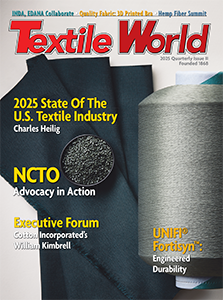Birdair, Inc., the leading specialty contractor of lightweight long-span roofing systems and
tensile structures throughout the world, recently engineered and constructed a fabric membrane for
a new parking terminal at Indianapolis International Airport, Indianapolis, IN.
In an effort to update and expand the current facility, renovations to Indianapolis
International Airport include the replacement of the previous terminal building with a new,
state-of-the-art, 40-gate terminal facility. An adjacent parking garage, ground
transportation center and airfield will flank the new terminal, slated for completion in October
2008.
The new five-story, 2.5-million-square-foot parking garage, located immediately west of the
new terminal structure, was designed to accommodate 5,900 cars and 1,200 rental cars. As an
integral part of the structure’s contemporary design, the new parkade features a Birdair PTFE
fabric membrane installed as helical canopies designed to emulate the spirals of the ramps
themselves. Approximately 75,000 square-feet of PTFE material forms the two 100-foot diameter
helical ramp canopies and the 500-foot center atrium spine canopy.
ARCHonsortium LLC, Indianapolis, IN, selected the fabric membrane for its modern visual
appeal and versatility, as well as its optimum performance record for structures located in varying
climate zones. Birdair’s ability to overcome design and engineering challenges that other specialty
contractors would not have been able to meet was vital to the project’s success.
“One of the primary challenges we faced with this project was maintaining an acceptable
adherence to the design concept for the helical canopies, given the desire that the structures
follow the
spirals of the ramps themselves, and that they essentially cantilever from the inner core
ramp structure without additional visible structure at their peripheries,” explains David R.
Franklin, AIA, of Domain Architecture Inc., Indianapolis, IN, a member firm of ARCHonsortium.
“Birdair devised a single unobtrusive strut that ultimately served both our aesthetic preferences
and their own structural needs.”
“Birdair’s innovative engineering solutions continue to meet building challenges that
maintain initial design intent,” says Kevin Mayer, Birdair vice president of business development.
“Our coordinated construction and engineering efforts allow for unparalleled custom design and
fabrication of tensile structures throughout the world.”
“I am extremely pleased with the installation of the product, as well as Birdair engineers’
execution of our design intent, particularly for the helical ramp canopies,” adds Franklin.
Birdair has fabricated a number of tensile structures in the Indianapolis area, including
Methodist Hospital and the RCA Dome (formerly the Hoosier Dome), a project in which Franklin was
involved with prior to establishing Domain Architecture.
“Our familiarity with Birdair projects in the Indianapolis and North Carolina areas led to
our decision to select Birdair,” continues Franklin. “They were able to successfully meet the
challenges associated with the project.”
Planning for the new $1.1 billion Indianapolis Airport terminal began in 1975, with
construction beginning in 2001. Construction on the $92- million parking structure and
attached ground transportation center began in July 2005 and will be completed in July 2008.
The 1,200,000- square-foot terminal will officially open to the public on October 28, 2008.
The new structure will meet modern security, parking, baggage handling, communications and
other systems requirements. Its location between the airport’s two major runways will reduce
noise and pollution while saving taxiing time and fuel.
The parking structure project team consists of a group of firms called ARCHonsortium, LLC,
Indianapolis, IN. (www.archonsortium.net). As part of the
group, Franklin served as chief designer for all Birdair components of the parking garage as well
as for the attached ground transportation center. F.A. Wilhelm Construction Co., Inc.,
Indianapolis, IN, served as general contractor. The Indianapolis
Airport Authority, Indianapolis IN, is the facility owner.
“With some admitted bias, I think the spiraling canopies for the helical ramps at the
Indianapolis airport parking structure are the most elegant and unique I have seen, and I must
compliment Birdair on their execution and engineering,” notes Franklin.
PTFE, or Polytetrafluoroethylene, is a Teflon®-coated woven fiberglass membrane that is
extremely durable and weather resistant; it is capable of withstanding temperatures from -100°F to
+450°F, immune to UV rays, and waterproof.
About Birdair: Birdair, Inc. is the leading specialty contractor of lightweight long-span
roofing systems and tensile structures throughout the world, providing design-build solutions for
architects and clients in all aspects of project design, engineering, installation and
maintenance. Lightweight long-span roofing systems and cable structures can be attached to
any building envelope and
offer aesthetic and functional options to complement any exterior design. Birdair,
based in Buffalo, NY, is a member of the Taiyo Kogyo Group, with operations serving North and South
America and other international locations. For more information about Birdair, call
1-800-622-2246 or visit
www.birdair.com.
October 28, 2008
Press Release Courtesy of Birdair Inc.




